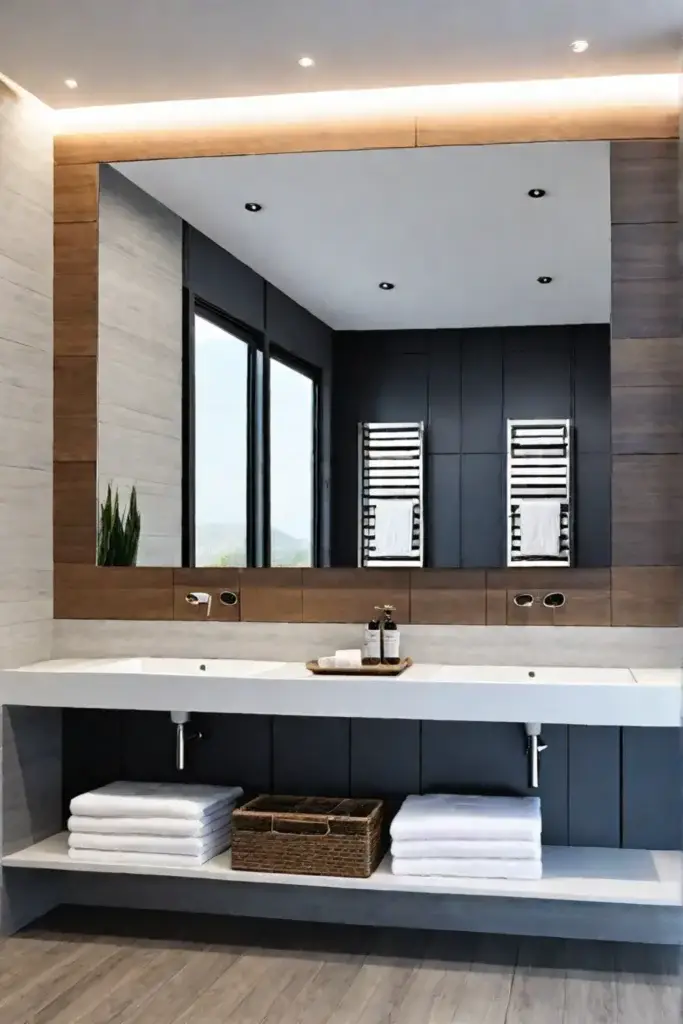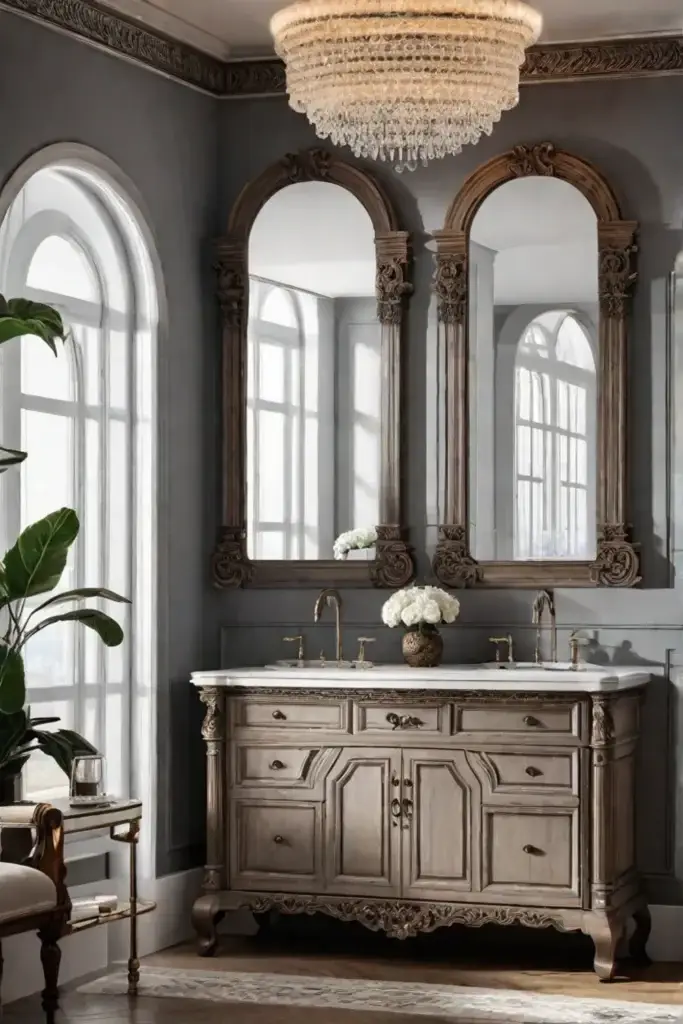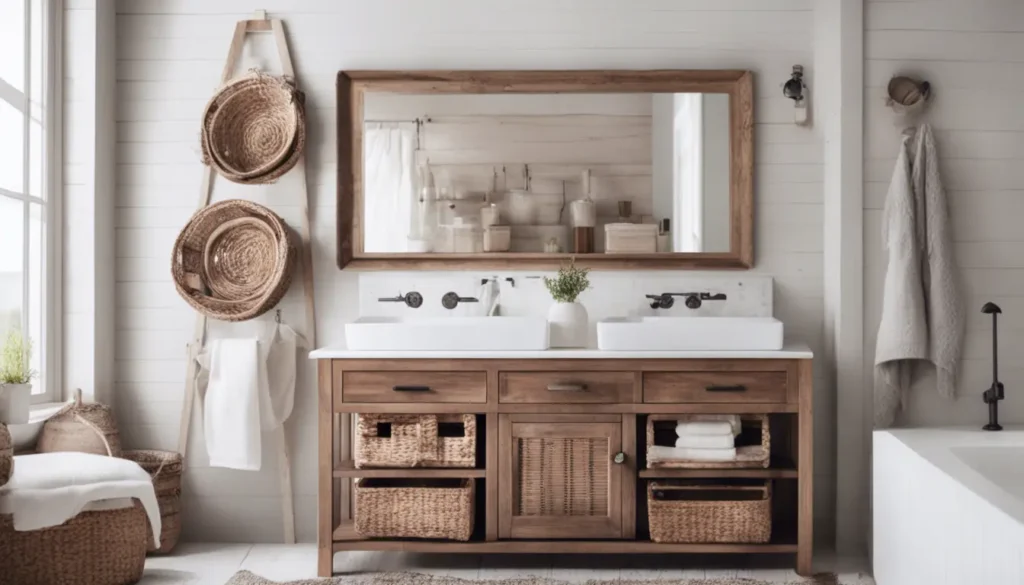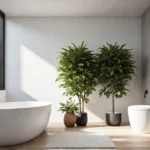Have you ever walked into a bathroom and felt like it was missing something? Maybe the sink and vanity combo didn’t fit the overall vibe you were going for. As an interior designer, I know how crucial it is to get this essential element right. Your bathroom sink and vanity are the show’s stars – they set the tone for the entire space.
That’s why I’m excited to share 12 stunning bathroom sink and vanity combinations that can refresh your space. Whether you’re drawn to modern farmhouse charm, vintage elegance, or sleek industrial flair, there’s a perfect pairing out there.
In this article, we’ll dive into the latest design trends, explore a range of materials and finishes, and uncover innovative features that can elevate your bathroom to new heights. We’ll also discuss coordinating the perfect sink and vanity duo, considering layout and design factors, and addressing budgeting concerns. By the end, you’ll be armed with the knowledge to create a bathroom that’s functional and a true reflection of your style.

So, let’s get started on your bathroom transformation journey!
Trending Bathroom Sink and Vanity Styles
In recent years, bathroom design has evolved significantly, with various styles emerging to suit multiple tastes and preferences. From the cozy charm of modern farmhouses to the bold, edgy vibe of industrial-inspired spaces, there’s something for every homeowner.
One of the hottest trends in bathroom design is the modern farmhouse aesthetic. This style blends rustic elements like natural wood and stone with clean, contemporary lines. Imagine a wooden vanity with a white porcelain sink set atop a sleek granite countertop – the perfect balance of old and new.
For those who appreciate mid-century modern flair, a low-profile, floating vanity made of warm walnut wood paired with a round, white ceramic sink can create a stunning focal point. This style’s streamlined silhouettes and organic shapes exude timeless sophistication.

On the other hand, if you’re drawn to a more industrial vibe, consider a large stainless steel sink mounted directly onto the wall, accompanied by a black metal vanity unit. This edgy combination can instantly transform your bathroom into an urban oasis.
Let’s not forget the resurgence of vintage and retro-inspired styles. Whether you’re captivated by the whimsical curves and pastel hues of Art Deco or the bold, graphic patterns of the 1970s, there are plenty of ways to incorporate these historical influences into your bathroom design.
Interestingly, the popularity of floating vanities has also been on the rise. These wall-mounted units keep the floor clear and create the illusion of a larger, more open space. They offer a sleek, contemporary look that seamlessly integrates with various sink styles and bathroom aesthetics.
Materials and Finishes
Choosing materials and finishes plays a crucial role in creating stunning bathroom sink and vanity combinations. Many options exist, from the timeless elegance of natural stone to the easy-to-clean convenience of ceramic and porcelain.
Ceramic and porcelain sinks and vanities are perennial favorites due to their durability, staining resistance, and effortless maintenance. These materials come in various colors and styles, making them versatile for any bathroom design.

Natural stone, such as marble, granite, and travertine, offer luxury and timeless appeal. However, these materials require more care, including regular sealing and cleaning, to maintain their pristine appearance.
For a modern, low-maintenance option, consider quartz countertops. These non-porous surfaces resist scratches and stains, making them popular among homeowners. Quartz comes in various colors and patterns, allowing you to achieve a customized look.
Wooden sinks and vanities can add warmth and rustic charm to your bathroom, but they require more maintenance than other materials, especially in high-moisture environments.
Metal sinks, particularly in finishes like copper and brass, can lend an industrial edge to your bathroom design. These materials are durable and easy to clean but may develop a patina over time, which some homeowners find appealing.
As homeowners become more conscious of their environmental impact, sustainable materials like recycled glass, bamboo, and reclaimed wood are gaining traction in bathroom design. These eco-friendly options look great and align with a more sustainable lifestyle.

When selecting materials and finishes, consider factors such as your style, the overall functionality of your bathroom, and the perceived size and feel of the space. Mixing different textures and finishes can create visual interest, but it’s important to maintain a sense of balance and cohesion throughout your design.
Sink Styles and Features
Bathroom sinks come in a wide range of styles, each with unique characteristics and benefits. From the seamless integration of undermount sinks to the statement-making presence of vessel sinks, there’s an option to suit every bathroom layout and design aesthetic.
Undermount sinks, installed below the countertop, offer a clean, streamlined look and make cleaning around the edges a breeze. These sinks pair well with various countertop materials, including granite, quartz, and solid surfaces.

On the other hand, drop-in sinks sit atop the countertop and require a lip around the edges to hold them in place. This style provides more flexibility regarding countertop selection but may not offer the same sleek appearance as undermount sinks.
Consider a vessel sink for a truly eye-catching focal point. These sinks stand above the countertop, often showcasing glass, ceramic, or metal materials. While they add a touch of luxury, vessel sinks require additional consideration for the height of the surrounding countertop and vanity.
Pedestal sinks, with their single support column beneath the basin, create an airy, minimalist look without a vanity or countertop. This style is ideal for small bathrooms or those seeking a clean, uncluttered aesthetic.
Wall-mounted sinks, which attach directly to the wall, offer versatility in placement and easy access to the plumbing fixtures behind them. This modern option is great for compact spaces or contemporary bathroom designs.
In addition to the various sink styles, homeowners can explore innovative features that enhance functionality and aesthetics. Integrated overflow systems, touchless faucets, and self-cleaning coatings are just a few examples of the advancements in sink technology that can make your bathroom experience more convenient and hygienic.

Consider your bathroom layout, personal preferences, and functional needs when selecting a sink. By understanding the diverse range of sink styles and features available, you can find the perfect solution to complement your bathroom design and meet your practical requirements.
Vanity Designs and Storage Solutions
Vanities play a crucial role in your bathroom’s visual appeal and functionality. From single-sink to double-sink options, freestanding to floating designs, there are many choices to explore.
For smaller bathrooms, a single-sink vanity can provide ample countertop space for your daily grooming essentials. Conversely, a double-sink vanity is an excellent choice for couples or larger families, allowing for separate personal spaces.
Floating vanities mount directly to the wall and offer a sleek, modern look. They also free up floor space, which can be particularly useful in compact bathrooms.
If you have more room to work with, a freestanding vanity can add a touch of elegance and versatility to your design. These standalone units come in various styles, from traditional to contemporary, and often feature integrated storage solutions.

Concerning storage, vanities can be equipped with various built-in features to keep your bathroom organized and clutter-free. Drawers, shelves, and cabinets provide convenient places to store everything from toiletries to towels, ensuring your space stays tidy and functional.
Interestingly, the demand for customizable and personalized vanity solutions has increased as homeowners seek unique designs catering to their needs and preferences. Additionally, incorporating smart storage features, such as pull-out trays and adjustable shelving, has become increasingly popular to maximize the available space.
When selecting a vanity for your bathroom, consider the size of the room, your storage requirements, and the overall aesthetic you aim to achieve. By carefully balancing these factors, you can create a visually appealing and highly functional bathroom.
Coordinating Sink and Vanity Combinations
Choosing the perfect sink and vanity combination is an art form that can elevate your bathroom’s overall design. When these two elements work together harmoniously, the result is a space that is not only beautiful but also highly functional.
Size and shape are crucial when pairing a sink and vanity. Ensure that the scale and proportion of these elements are appropriate for the size of your bathroom, as a mismatched combination can throw off the overall balance of the space.

Matching the material and finish of the sink and vanity can also help maintain a cohesive look. Whether you opt for a sleek, polished quartz countertop or a warm, wooden vanity, coordinating these elements can create a visually stunning and cohesive design.
It’s also important to consider the balance of design elements within the space. If you choose a bold, statement-making sink, you may want to pair it with a more subtle vanity to avoid overwhelming the room. Conversely, a simple, understated sink can be elevated by a vanity with intricate detailing or a unique finish.
Don’t forget to factor in lighting and accessories when coordinating your sink and vanity combination. These elements can help tie the entire design together and enhance the functionality of your bathroom.
You might envision a sleek, stone countertop vanity with a matching porcelain sink in a crisp white finish for a modern minimalist look. This clean and elegant combination creates a sense of openness and tranquility.
On the other hand, for those who prefer a more rustic charm, a wooden vanity with a farmhouse-style copper or stainless steel sink can evoke warmth and character. The interplay of natural materials adds depth and texture to the space.

Ultimately, the key to a successful sink and vanity combination is balancing the various design elements to create a cohesive and visually appealing bathroom. By considering factors like size, shape, material, and finish, you can achieve a stunning result that reflects your style and meets your functional needs.
Bathroom Layout and Design Considerations
When selecting the perfect bathroom sink and vanity combination, it’s crucial to consider your space’s overall layout and design. After all, these elements need to look great and seamlessly integrate with your bathroom’s existing features and flow.
The size of your bathroom plays a significant role in determining the type of sink and vanity that will work best. For example, a small powder room may be better suited for a pedestal sink, while a larger main bathroom could accommodate a double-basin vanity.
Another important factor to consider is the location of your plumbing lines. If there isn’t enough space between the walls, you may need a wall-mounted faucet instead of a deck-mounted one to ensure a proper fit.

The flow of traffic within your bathroom is also a crucial consideration. Ensure that the sink and vanity placement don’t obstruct movement or create any bottlenecks. Ideally, they should be positioned against a wall, leaving ample space for people to move around comfortably.
Lighting is another essential element in bathroom design. Natural light should be maximized through the strategic placement of windows or skylights. Artificial lighting, such as overhead fixtures, sconces, and LED strips, can also significantly enhance the overall ambiance and functionality of the space.
Mirrors are another important design feature that can make a small bathroom appear larger by reflecting light and creating the illusion of depth. Choose mirrors that complement your bathroom’s style and color scheme, and consider the placement to ensure optimal visibility and functionality.
Accessories, such as towel bars, toilet paper holders, and soap dishes, can also contribute to your bathroom’s overall aesthetic and organization. Incorporate these elements thoughtfully to create a cohesive and visually appealing design.

The design challenges can be a bit more complex for those with an open-concept bathroom. These spaces require careful planning to balance privacy, functionality, and aesthetics, ensuring that the sink and vanity combination seamlessly integrates with the overall layout.
Additionally, incorporating universal design principles can make your bathroom more accessible for all users, regardless of age or ability. Features like grab bars, non-slip flooring, and adjustable mirrors can enhance the usability and safety of your space.
By considering your bathroom’s layout and design factors, you can ensure that your chosen sink and vanity combination looks stunning and functions seamlessly within the overall space.
Budgeting and Cost Considerations
When selecting the perfect bathroom sink and vanity combination, budget is a crucial factor to consider. Balancing your design aspirations with your financial constraints can be a delicate dance, but with careful planning, you can find the right solution that meets your needs without breaking the bank.
Several elements can influence the cost of your bathroom sink and vanity, including the materials used, the size of the fixtures, and any additional features or customizations.

The material choice can significantly impact the price tag. For instance, solid wood vanities are more expensive than particle board ones, while marble sinks often cost more than their ceramic counterparts. The level of customization or unique design elements can also drive up the overall cost.
The size of your sink and vanity can also affect the price. Larger fixtures generally require more materials and labor, resulting in a higher price tag. On the other hand, compact options like pedestal sinks may come with a premium due to their space-saving design.
Regarding installation, professional services can add to the final cost, especially if extensive plumbing work is required. However, opting for a DIY installation can be cost-effective, provided you have the necessary skills and resources.
To create a realistic budget for your bathroom renovation, start by determining your total project budget, then prioritize your spending based on your must-have features and design goals. Compare prices from various retailers and manufacturers to find the best deals, and consider more affordable alternatives like modular vanities or pre-fabricated countertop units.

It’s worth noting that the demand for high-end and custom-made bathroom fixtures has increased as homeowners seek unique and personalized solutions. While these options can be more expensive, they allow you to tailor the design to your needs and preferences.
Additionally, the growing popularity of sustainable and eco-friendly materials, such as bamboo or recycled glass, has introduced more budget-friendly alternatives for those looking to incorporate environmentally conscious choices into their bathroom design.
By carefully considering your budget and cost factors, you can find the perfect bathroom sink and vanity combination that aligns with your design goals and financial constraints, ensuring a stunning and functional result.
Maintenance and Longevity
When investing in a new bathroom sink and vanity combination, it’s essential to consider the aesthetic appeal and the long-term durability and maintenance requirements. After all, you want your bathroom fixtures to look great and stand the test of time.

The quality of the materials used plays a significant role in the longevity of your bathroom sink and vanity. High-quality, non-porous materials like solid surface, quartz, and porcelain are known for their resilience against scratches, stains, and fading, making them a wise investment.
On the other hand, natural stone options like marble and granite require more maintenance, including regular sealing and cleaning, to prevent damage from water exposure and acidic substances.
The construction quality of the sink and vanity is also crucial. Well-built fixtures with reinforced joints, strong mounting systems, and stable bases are more likely to withstand a busy bathroom’s daily wear and tear.
The finish of your sink and vanity can also impact their resistance to damage. Matte finishes, for example, tend to hide fingerprints and minor scratches better than glossy surfaces, which may show scuffs more easily.

Proper cleaning and maintenance are key to preserving the beauty and functionality of your bathroom fixtures. Avoid harsh chemicals and abrasive cleaners, and instead opt for gentle, non-toxic products. Regular wiping down with a soft cloth can help remove any buildup and maintain the shine.
One factor that can significantly impact the lifespan of your bathroom sink and vanity is the presence of hard water. The high mineral content in hard water can leave unsightly residue and stains on your fixtures, potentially causing damage over time. Installing a water softener or a descaling solution can help mitigate this issue.
Exposure to extreme temperatures, sunlight, and humidity can also take a toll on your bathroom fixtures. Be mindful of these environmental factors when selecting materials and determining the placement of your sink and vanity.
As homeowners become increasingly conscious of convenience and ease of maintenance, the demand for low-maintenance, durable bathroom solutions has risen. Materials like quartz and solid surface composites, which resist stains and scratches, have become popular choices for those who want to enjoy the aesthetic benefits without the hassle of frequent cleaning or repairs.

By considering the maintenance and longevity aspects of your bathroom sink and vanity combination, you can make informed decisions that will provide lasting value and satisfaction, ensuring your bathroom remains a beautiful and functional oasis for years to come.
Conclusion
In the ever-evolving world of bathroom design, the perfect sink and vanity combination can transform your space. From the cozy charm of the modern farmhouse to the sleek sophistication of mid-century modern, the options are endless when creating a stunning and functional bathroom that reflects your style.






